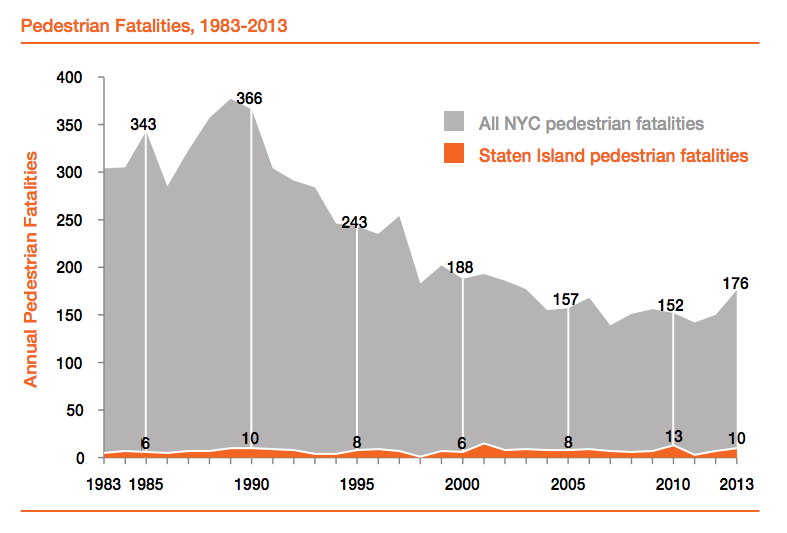
When it comes to traffic safety in Staten Island, there’s good news and there’s bad news.
The good news first: Staten Island has the lowest rate of pedestrian deaths of all five boroughs, according to Mayor DeBlasio’s just-released Vision Zero report, as reported on Streetsblog. Over the past three decades, Staten Island’s pedestrian fatality rate of 1.4 deaths per 100,000 residents is the lower than that of Brooklyn, Queens, Manhattan or The Bronx.
The bad news? Staten Island is the only borough that isn’t making any progress. In 30 years, as pedestrian fatalities across New York have been cut in half, Staten Island has remained the same. Every year on average 40 pedestrians are severely injured and seven are killed on Staten Island streets.
Graph from the NYC Department of Transportation’s Pedestrian Safety Action Plan for Staten Island [PDF]
Comparing Staten Island to the other boroughs may be like comparing apples to oranges. Staten Island is the most auto-dependent borough and the least populous. There simply aren’t as many pedestrians per capita, because most people need to use their cars to get around. St
Vision Zero, the mayor’s initiative, seeks to end all traffic related-deaths in the city. The DOT and NYPD have developed a Pedestrian Safety Action Plan to address the specific challenges facing each borough:
In Staten Island the main causes of pedestrian injury and death are failure to yield to pedestrians in crossings, and speeding. The most vulnerable residents are seniors, while the most dangerous time of day is 3-9 p.m., which accounts for 80 percent of fatalities.
The Vision Zero safety Plan has also identified Priority intersections and Priority Corridors to address the areas most in need of improvement. The 17 Priority intersections include Hylan Boulevard and Jefferson Avenue, Norway Avenue, Hylan Boulevard and Clove Road, and Manor Road and Victory Boulevard.
The 16 Priority Corridors, comprising 53 miles of road in the North and East Shores areas where most pedestrian injuries and fatalities occur, include Forest Avenue from Victory Boulevard to Goethals Road North, and Vanderbilt Avenue from Bay Street to Richmond Road.
What to expect
Under Vision Zero, at least 50 safety engineering improvements will be made every year, at Priority Corridors, Intersections, and Areas citywide. By the end of 2017, you can expect to see:
— Longer crossing times for pedestrians on all Staten Island Priority Corridors and all feasible Intersections
— Modified signal timing to reduce off-peak speeding on all feasible Staten Island Priority Corridors
What you can do
Cars are an important part of Staten Island life, but it’s still important to share the road with pedestrians and cyclists. Slow down, watch for speed limit changes and future red-light cameras, and always yield to pedestrians. Seniors are especially at risk and need extra time to cross.
Staten Island should be proud of its relatively low pedestrian fatality rates. With a little effort, it might be the first borough to get deaths down to zero.

